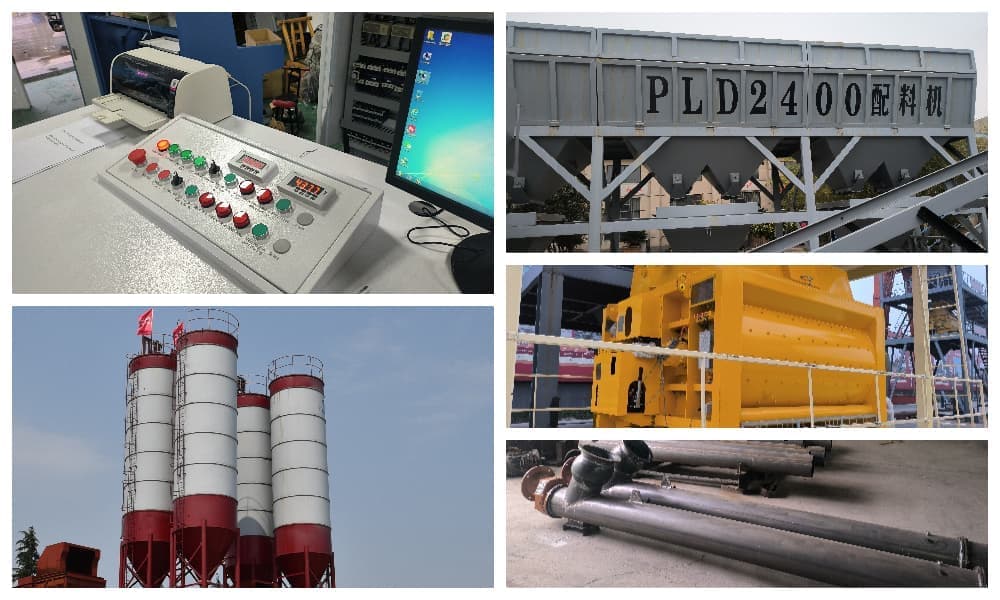How Much does a Mobile Concrete Batch Plant Cost?

Mobile concrete batching plants are becoming increasingly popular in the construction industry due to their convenience and flexibility. They can be quickly deployed to various construction sites, reducing transport costs and time. However, how much money does it cost to purchase a mobile concrete batching plant? This article will delve into the various factors that affect the cost of a mobile concrete batching plant and provide some examples of price ranges.
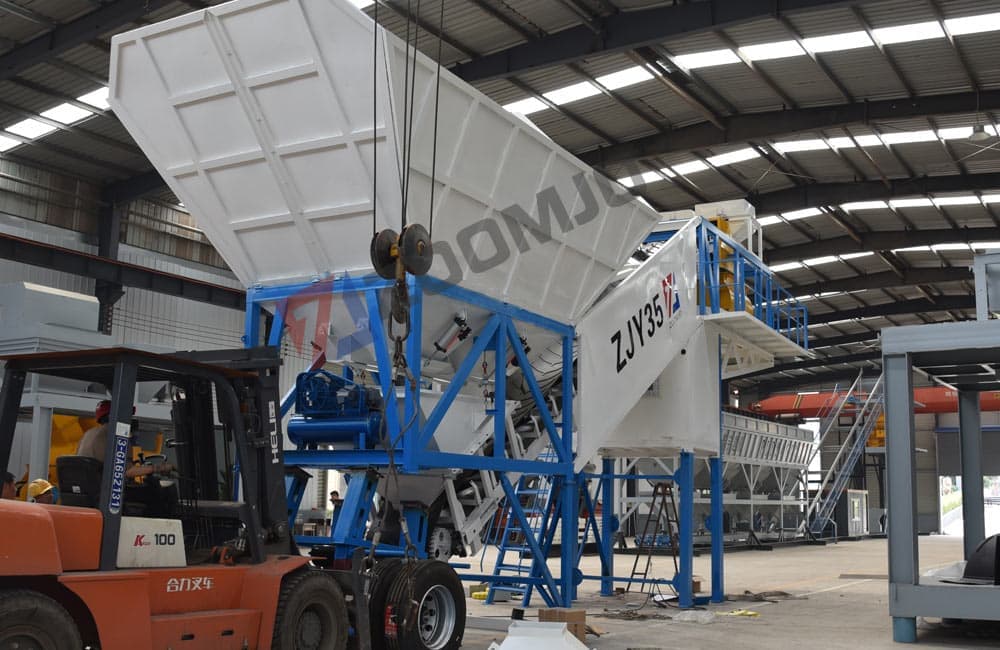
Price range for a mobile concrete batching plant
Prices for mobile concrete batching plants vary widely, typically ranging from $28,000 to $210,000. This price range is influenced by a combination of factors, including production capacity, mixing technology, configured features, brand and manufacturer.
To get a clearer picture of the price range of different sized batching plants, we have broadly categorised them into the following categories based on production capacity:
-
Small mobile batching plants (25-35 cubic metres per hour): These are typically priced between $35,000 and $60,000. They are compact and mobile, and are suitable for small projects, temporary sites or operations that require frequent transfers. They are often used, for example, for rural road construction, small building sites, etc.
-
Medium-sized mobile batching plants (50-60 m3/hour): Medium-sized batching plants typically range in price from $57,000 to $148,000. They offer a good balance between capacity and flexibility and are suitable for medium-sized construction projects such as town infrastructure, medium-sized bridges, etc.
-
Large mobile batching plants (100 m3 /hour and above): Large mobile batching plants are usually priced between US $120,000 and US $210,500 or more. This type of plant has the capacity to meet the concrete needs of large projects such as motorways, large bridges, airports, ports and other major infrastructure.
Latest Price List of Mobile Concrete Batching Plant
The common models of mobile concrete mixing plant include YHZS25, YHZS35, YHZS50 and YHZS75.According to the latest market research, the following is the price collation of these models. It is worth noting that YHZS stands for Mobile Concrete Batching Plant and the number after it indicates its theoretical production capacity (unit: cubic metre per hour).
| Model | Theoretical production capacity | Price range | Main Configuration |
|---|---|---|---|
| YHZS25 | 25 m³/h | Above $35,000 | JS500 mixer, PLD1200 batching machine, discharging height 3800mm |
| YHZS35 | 35 m³/h | Above USD52,000 | JS750 mixer, PLD1600 batching machine, discharging height 3800mm |
| YHZS50 | 50 m³/h | Above USD 74,500,000 | JS1000 mixer, PLD2400 batching machine, discharging height 3800mm |
| YHZS75 | 75 m³/h | Above USD 93,800,000 | JS1500 mixer, PLD3200 batching machine, discharging height 3800mm |
These prices may vary depending on manufacturer, configuration and additional features.
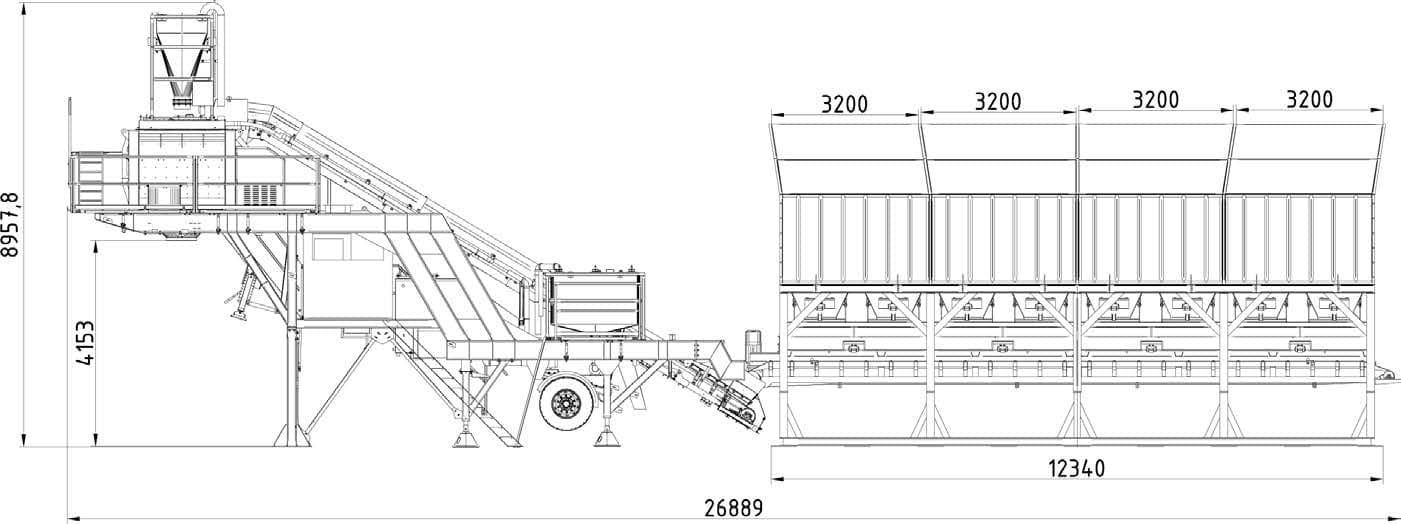
Key factors affecting the price of mobile concrete batching plant
Buying a mobile concrete batching plant is an important investment, and its price is affected by a combination of factors. Below is a detailed description of the key factors affecting the price:
1. The technical specifications and configuration of the equipment itself:
Production capacity: This is the most important factor affecting the price. Production capacity is measured in cubic metres of concrete per hour (m³/h). The greater the capacity, the greater the size, power and technical complexity of the equipment required, and therefore the higher the price. For example, a batching plant producing 25 cubic metres per hour is certainly much cheaper than one producing 100 cubic metres per hour.
Mixer type: The mixer is the heart of the batching plant. Common mixer types include:
-
Drum mixer: Simple structure, low cost, suitable for small-scale projects or projects with low requirements on concrete quality.
-
Forced mixer (including double horizontal shaft and planetary type): high mixing efficiency, good concrete quality, suitable for various types of concrete production, but the price is relatively high. Among them, planetary mixers are usually more expensive than double horizontal shaft mixers, but they have better mixing uniformity and are especially suitable for the production of high-performance concrete.
Batching system: The accuracy and automation of the batching system directly affects the quality and productivity of the concrete. Higher precision batching systems (e.g. with electronic weighing and microcomputer control) are more expensive. Types of batching systems include:
-
Aggregate batcher: Used for storing and metering aggregates such as sand and gravel. The number and capacity of silos and the type of metering (e.g. belt scales or volumetric batching) will affect the price.
-
Cement and powder batching systems: These include cement silos, screw conveyors, weighing scales, and so on. The capacity, number and type of cement silos (e.g. welded or assembled) will also affect the price.
-
Water and Admixture Batching Systems: Used to accurately measure water and various admixtures. The accuracy of metering and the degree of automation are key factors affecting the price.
Control system: The higher the degree of automation of the control system, the simpler the operation, the higher the production efficiency, but also the higher the price. Advanced control systems usually have the following features:
-
Automatic batching and mixing control
-
Data logging and report generation
-
Remote monitoring and diagnostics
-
Fault alarms and protection
Other Components and Features: Other components and features that affect price include:
-
Conveying systems: Such as belt conveyors, inclined belt conveyors, etc., whose length, width, and conveying capacity affect price.
-
Dedusting systems: Used to reduce dust pollution, often required in areas with high environmental requirements.
-
Aggregate storage bins and hoppers: capacity and quantity will affect the price.
-
Other auxiliary equipment: such as air compressors, pumps and so on.
2. Mobility and chassis:
Chassis types: The main types of chassis for mobile batching plants are tractor-trailer and trailer-trailer. Tractor-trailer batching plants require a tractor to tow them, while trailer-trailer batching plants are self-powered. Different types of chassis differ in structural strength, mobility and price.
Mode of Mobility: Some mobile batching plants have a modular design that allows for quick disassembly and transport, and this design is usually more expensive.
3. Brand and manufacturer:
Famous brands or manufacturers with advanced technology are usually more expensive as their products are more guaranteed in terms of quality, performance and after-sales service.
4. Other factors affecting costs:
-
Transport costs: Transport distance, mode of transport and difficulty of transport all affect transport costs.
-
Installation and commissioning costs: including equipment installation, electrical wiring, system commissioning and other costs.
-
Infrastructure costs (for semi-mobile): Although mobile batching plants require less infrastructure, in some cases simple site levelling and hardening is still required.
-
Operating costs: including energy consumption, labour costs, maintenance costs and replacement of wearing parts.
-
Customised requirements: Customised design and production according to the user's specific needs will add additional costs.
-
Regional factors: Labour costs, raw material prices and market competition in different regions will also affect the price.
In short, to buy a mobile concrete batching plant, you need to consider the above factors and choose the most suitable equipment according to your project needs, budget and specific circumstances. It is recommended to communicate in detail with several suppliers to obtain detailed quotations and technical parameters, and make full comparison and evaluation before purchase.
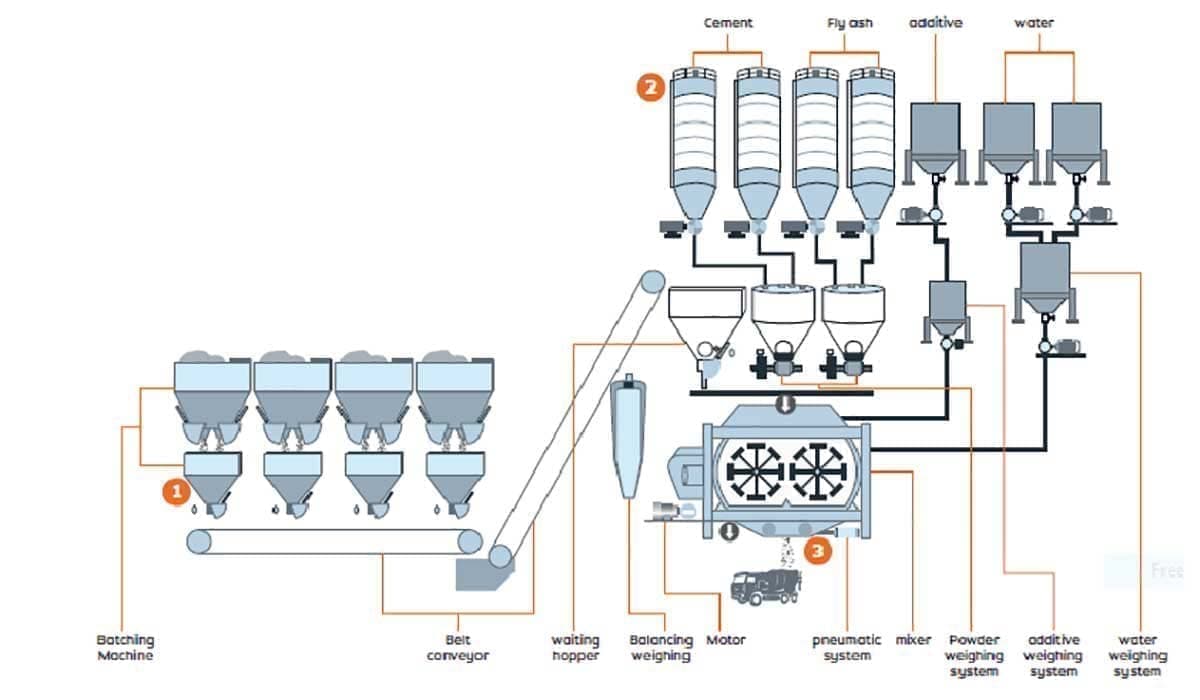
Concrete Batching Plant Investment Advice
Investing in a concrete batching plant is an important decision that requires careful evaluation of several factors to ensure return on investment and project success. Below are some key investment recommendations:
1. Select the equipment model with the right capacity according to the project needs:
-
Define the type and size of the project: First of all, it is important to define whether the project is for infrastructure construction (e.g., roads, bridges, railways), commercial construction, residential construction, or other types. Different types of projects have different requirements for the amount, strength and performance of concrete. Based on the total concrete usage and duration of the project, the required daily and hourly production can be estimated.
-
Calculating Concrete Requirements: It is critical to accurately estimate the total amount of concrete required for a project. This takes into account the volume of the building, structural design and construction schedule.
-
Determine the capacity of the mixing plant: Based on the estimated concrete demand and the duration of the project, select the appropriate type of mixing plant. The type of mixing plant is usually expressed in terms of theoretical production capacity per hour (m³/h). The selection should ensure that the theoretical production capacity of the chosen model is slightly greater than the actual demand to cope with unforeseen circumstances or production peaks. For example, if a project requires 80 cubic metres of concrete per hour at peak times, a 90 m³/h or 120 m³/h plant may be more appropriate.
-
Consider future growth: If more projects or business expansions are expected in the future, consider choosing a plant with a slightly larger capacity to avoid frequent equipment changes.
2. Consider the project cycle to choose between stationary or mobile:
-
Stationary Batching Plants: Suitable for large, long-term projects or located at concrete production sites. The advantages are large production capacity, good stability and relatively low long-term operating costs. The disadvantages are that it is more complicated to install and dismantle, and is not suitable for frequent site changes.
-
Mobile mixing plant: Suitable for small and medium-sized, short-term projects, or projects that require frequent site changes. The advantages are easy to move, quick installation and high flexibility. The disadvantages are that the production capacity is relatively small and the initial investment may be slightly higher.
-
Semi-fixed mixing plant: Between fixed and mobile, can be relocated to a certain extent, but not as flexible as mobile.
Selection basis:
-
Project duration: Mobile is usually chosen for short-term projects (a few months to a year or two); fixed is usually chosen for long-term projects (several years or more).
-
Site location: mobile if the site is dispersed or needs to be changed frequently; fixed if the site is centralised and stable over a long period of time.
-
Project size: large projects usually choose fixed or large mobile; small projects usually choose small mobile.
3. Evaluate the overall investment cost, including the cost of equipment, transport, installation and so on:
-
Equipment purchase cost: This is the main part of the investment, including the mixing machine, batching system, control system, conveying system, silo and so on.
-
Transportation costs: the cost of transporting the equipment from the manufacturer to the site, including land, sea or rail transport.
-
Installation and commissioning cost: including the cost of equipment infrastructure, installation, electrical wiring, system commissioning and so on.
-
Infrastructure Costs (for stationary): Includes the cost of site levelling, hardening, drainage, office and living quarters.
-
Operating costs: including energy consumption (electricity, oil), labour costs, maintenance costs, wearing parts replacement costs.
-
Other costs: including design fees, supervision fees, taxes, insurance fees, etc.
-
Detailed cost budgeting: Before investing, make sure you have a detailed cost budget and set aside a certain amount of contingency to cover unforeseen expenses.
4. Pay attention to after-sales service and maintenance support:
Choose a reputable concrete mixing plant manufacturer or supplier: Choosing an experienced and reputable manufacturer or supplier with good after-sales service can guarantee the quality, performance and subsequent maintenance of the equipment.
Understand the content of after-sales service: Understand in detail the content of after-sales service provided by the manufacturer or supplier, including the warranty period of the equipment, technical support, spare parts supply, maintenance service and so on.
Sign a perfect contract: Before purchasing the equipment, be sure to sign a perfect contract with the manufacturer or supplier to clarify the rights and obligations of both parties, in order to avoid subsequent disputes.
Formulate a maintenance plan: Formulate a regular maintenance plan, which can prolong the service life of the equipment and reduce the incidence of malfunction.
Other recommendations:
-
Conduct Market Research: Understand local concrete market demand, competition and price levels.
-
Seek professional advice: You can consult professional engineering consulting firms or industry experts for more professional investment advice.
-
Consider environmental protection factors: Pay attention to environmental protection regulations and standards, choose equipment that meets environmental protection requirements, and take corresponding environmental protection measures, such as the configuration of dust removal systems, sewage treatment systems, and so on.
Through comprehensive consideration of the above factors and adequate preparation and planning, we can minimise investment risks and obtain good investment returns.
Invest in mobile concrete batching plant immediately and realise the benefits quickly!
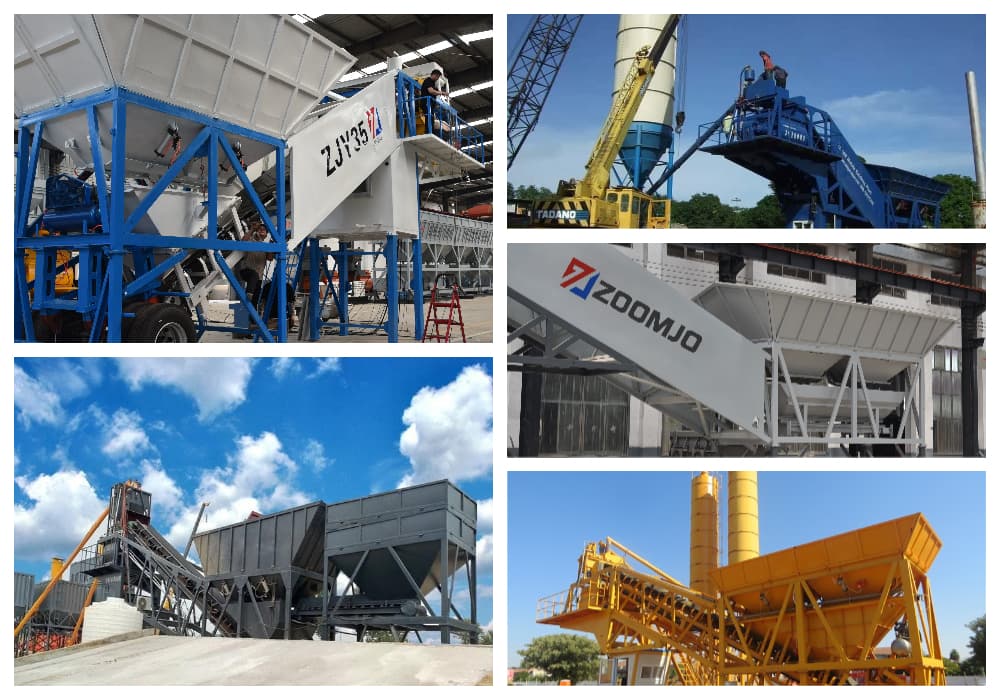
Frequently Asked Questions About Mobile Concrete Batching Plant
Q: What is a mobile concrete batching plant?
A: Mobile concrete batching plant is a concrete production equipment that integrates the material storage, weighing, conveying, mixing, unloading and automatic control system of the traditional stationary concrete batching plant on one or more movable trailer units.
Q: What is the difference between mobile concrete batching plant and fixed type?
-
A: Mobility: mobile plants can be easily dismantled and relocated, whereas stationary batching plants are usually installed in a long-term fixed location.
-
Footprint: Mobile plants have a smaller footprint and are suitable for tight spaces or temporary construction sites.
-
Installation time: Mobile plants take less time to install and commission, while fixed types require more time for infrastructure and installation.
Q: What are the main components of a mobile concrete batching plant?
-
A: Batching machine (usually 2-4 bins)
-
Mixing host (forced or self-falling)
-
Conveying system (belt conveyor or screw conveyor)
-
Control system (PLC automation control)
-
Water supply and metering system
-
Chassis and mobile unit (tyres, trailer towing system)
Q: What are the advantages of mobile concrete batching plant?
-
A: High mobility: It can quickly transfer the construction site, reducing the transfer time and cost.
-
Quick installation: Adopting modular design, it is easy and quick to install and dismantle.
-
Small footprint: Compared with the fixed mixing plant, the footprint is smaller and easier to arrange.
-
Low investment cost: compared with the construction of fixed mixing plant, the initial investment cost is lower.
-
Strong applicability: It is applicable to projects of various scales, especially suitable for projects with short construction period and site constraints.
Q: What is the production capacity of a set of mobile concrete batching plant?
A: The production capacity of mobile concrete batching plant is usually between 25m³/h and 120m³/h depending on the model. The choice of equipment should be determined according to the actual project requirements.
Q: Is the mobile concrete batching plant suitable for cold or hot areas?
-
A: It is suitable, but special measures need to be taken according to the environmental conditions:
-
Cold areas: Increase thermal insulation measures, use low temperature anti-freezing liquid or electric heating device.
-
High temperature areas: Equipped with shading systems, enhanced cooling and descaling devices.
Q: How long does it take to install a mobile concrete batching plant?
A: The installation time of a mobile concrete batching plant depends on the equipment configuration and site conditions. In general, simple mobile plants take less time to install and can be completed in as little as 3 days; standard and full-featured mobile plants take a little longer to install and can take a week or more.
Q: What types of projects are mobile concrete batching plants suitable for?
A: Mobile concrete batching plant is particularly suitable for the following types of projects:
-
Small and medium-sized construction projects: e.g. houses, roads and bridges.
-
Remote area projects: due to its flexibility, it is suitable for use in inaccessible areas.
-
Temporary projects: such as exhibitions, events and other projects that require short-term use.
Q: How long is the payback period of mobile concrete batching plant?
A: Generally speaking: the payback cycle of small-sized equipment may be around 1-2 years; medium-sized equipment is around 2-3 years; large-sized equipment may take 3-4 years or longer. The exact payback cycle needs to be assessed in detail according to the actual situation.
Q: What is the maintenance cycle of mobile concrete batching plant?
-
A: Daily inspection: It is recommended to do it before daily operation to ensure the normal condition and lubrication of all parts of the equipment.
-
Routine maintenance: carried out once a week, mainly including cleaning the equipment, checking the lubricant and fasteners.
-
Comprehensive maintenance: carried out every 3 to 6 months to ensure that the equipment is functioning properly and potential problems are identified and solved in a timely manner.

 English
English  Español
Español  简体中文
简体中文  Pусский
Pусский  українська
українська 